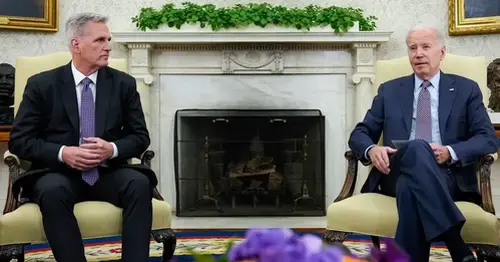
What's in the debt limit bill? Key provisions in the Biden-McCarthy deal to avert default
WASHINGTON — The bipartisan deal struck by Democratic President Joe Biden and Republican House Speaker Kevin McCarthy would extend the debt limit for two years alongside modest federal spending cuts and a series of policy provisions.
The 99-page Fiscal Responsibility Act, which McCarthy, R-Calif., says will get a vote in the Republican-led House on Wednesday, will need to pass the Democratic-controlled Senate before the June 5 deadline set by the Treasury Department to act or risk default.
Here's what is in the legislation:
Debt limit extension to 2025
The core of the deal is a suspension of the debt ceiling — currently at $31.4 trillion — until Jan. 1, 2025. The Treasury Department could then use "extraordinary measures" to pay the bills, which typically last for months.
That effectively resolves the issue through the 2024 election, leaving it to the next president and the new Congress to deal with.
Spending levels
The agreement includes spending caps for the next two years to set up the appropriations process. In fiscal year 2024, it would limit military spending to $886 billion and nonmilitary discretionary spending to $704 billion. In fiscal year 2025, those numbers would rise to about $895 billion and $711 billion.
McCarthy said the deal was "historic," as it would amount to "cutting spending year-over-year for the first time in over a decade."
Factoring in adjustments, the White House projects that when veterans funding is set aside, nondefense spending would barely change — with a slight reduction overall from 2023 to 2024.
"It's flat. It's a difference of about $1 billion," a White House official said. "In a divided government, we're not going to get the kinds of [nondefense discretionary] increases that we would hope to get."
Conservative policy measures
What do House Republicans get?
The bill would rescind about $28 billion in unspent Covid relief funds. It would eliminate $1.4 billion in IRS funding and shift about $20 billion of the $80 billion provided to the agency through the Inflation Reduction Act to non-defense funds. It would restart federal student loan payments after a lengthy "pause" that began at the start of the pandemic. It would also slap work requirements for Supplemental Nutrition Assistance Program and Temporary Assistance for Needy Families benefits on people up to 55 years old (the current threshold is 50), with carve-outs for veterans and homeless people.
The bill would overhaul the National Environmental Policy Act to streamline permitting for projects; House Republicans tout it as "the first significant reforms to NEPA since 1982."
What's in it for Democrats?
The White House is touting it as a budget deal — not a ransom payment for a debt ceiling extension — and emphasizing the modesty of the spending cuts even though it faces a GOP-led House. It also notes that the bill would make "no changes to Medicaid" and leave Social Security and Medicare untouched. The White House says the bill would fully preserve the climate and clean energy provisions of last year's Inflation Reduction Act and leave Biden's executive action on student debt forgiveness untouched.
And it would avert a catastrophic default for the rest of Biden's first term.






